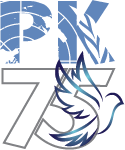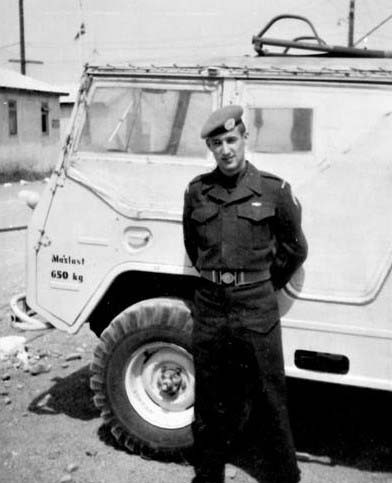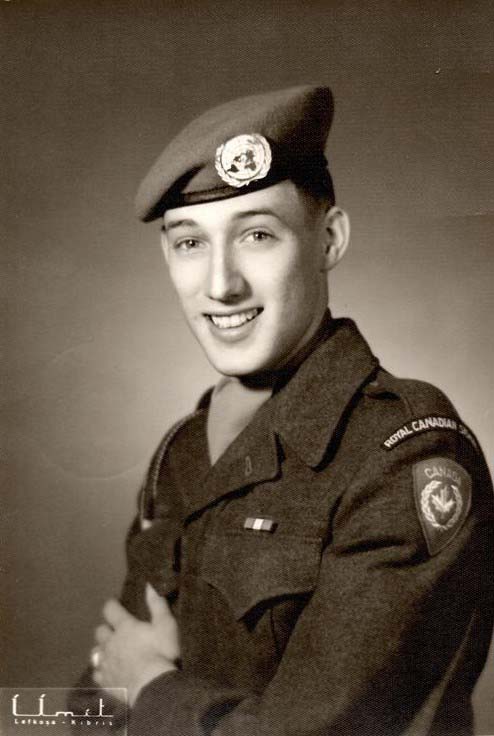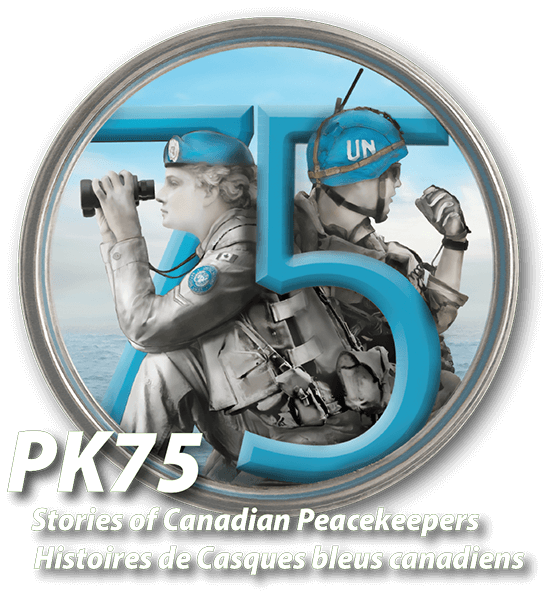

In October 1965 I arrived at Troodos Camp just outside of Nicosia, Cyprus. My heart swelled with pride when I saw the newly minted Canadian Flags at the gate and was comforted by the presence of the Canadian Guards Battalion manning the base. That same day I found myself to be one of four Canadian Signalers attached to Finnish Battalion Headquarters in Nicosia.
This was all new to me. I had no briefings on what to expect or guidance on how to deal with difficult situations except that I was not allowed to fire my weapon even if fired upon; seemed unfair to me.
Driving through Greek and Turkish road-blocks and check-points under the muzzles of machine guns was unnerving at first. It soon became normal. (This was a feeling I experienced again while doing mission work in Nicaragua.)
Canada provided communication services to non-English speaking U.N. contingents. I was a 19 year old Group One Signalman barely qualified in Morse Code with teletype and telephone switchboard skills. Four of us manned the com-centre 24 hours a day. Twelve-hour shift rotations gave us freedom to socialize with the Finns and explore Nicosia and the rest of the island in our Land Rover radio vehicle.
My time in Cyprus was easy. We seldom saw our Signals Officer and we were always forewarned so we could at least be properly turned-out. Our Finnish Signals Officer didn’t much bother with us either. I was quite often out of uniform wearing civilian beige shorts, a British Army Signals stable belt, a Finnish army camouflage jacket and dessert boots with strings instead of laces. But I did my job as best as I could.
The Finnish army units prepared their own rations. Every soldier learned to cook a nourishing but very basic meal, which was the same every day, potato soup. We preferred to drive to our evening meals with the Royal Canadian Dragoons, feasting on meals prepared in their field-kitchen by real cooks.
There were times that I felt threatened. Three of us went across town on bicycles to enjoy a movie and a few beers with the Dragoons. Returning to our billets we were held at gun point by an over-zealous Turkish soldier with a very big rifle and a desire to impress his superiors by extracting information from us. Our Lance Corporal drew himself up to his full height and we bluffed our way out of what could have been a nasty circumstance.
During an off-duty trip to Mount Olympus we were harassed by villagers hurling epitaphs and projectiles at our vehicle. Avoiding eye contact we drove slowly down the road. One never felt completely safe driving through the country-side because, as signalers we were privy to all reports of shots fired or increased tensions between Greeks and Turks.
Reports of incidents peaked when the United Nations mandate came up for renewal. We surmised that neither side was serious about an all out conflict at the time and that U.N. troops were putting too much money into the local economy to allow them to leave.
While in Cyprus I visited relatives posted to Germany and went to Beirut and Jerusalem. Cyprus was a personal growth experience, challenging my preconceived notions and instilling a yearn to travel. (Canada coast to coast, the Arctic, 40 other countries and still counting). While in the far-east my wife and I met a couple from Australia. The fellow, Frank, was a 10 year old living close to Finnish Battalion HQ in Cyprus when I was there. I believed in what we were doing and feel his life was better because of it.
We didn’t fraternize with the Greeks or Turks but those that I met seemed to me, politics aside, to be decent people just trying to do the best for their families.
The Finns treated us very well, drank straight vodka, sang, exchanged stories of home and gave us gifts. We Canadian signalers put on a special Christmas Eve party with care-packages from home. We shared a house and sauna and a com-centre. Working and living together we got to know them quite well. After five months with the Finns I was like a fish out of water during my month with the Swedes.
Biography
I was born in Ottawa in 1945, a War Baby; Germany had surrendered unconditionally and Japan had yet to experience the horrors of the atomic bomb. I watched British and American war movies and listened to the stories of the men who served; two of which survived the Dieppe Raid debacle.
My road to peacekeeping: Cub Scouts, Sea Scouts, and the Governor General’s Foot Guards where I learned about Nuclear Chemical Biological Warfare, how to survive an atomic blast or gas attack and how to extricate victims from collapsed buildings. Ever more powerful bombs, the space race, siren tests, air raid drills and films of nuclear explosions fed public fear that the Cold War would become Hot.
In 1962, at age 16, I joined the Royal Canadian Corps of Signals Soldier Apprentices, Vimy Barracks, at Kingston, ON. With parental permission I signed a five year contract with an optional additional two years. The program’s goal was to prepare young men for senior non-commissioned ranks. The program included; recruit and basic training, two years of high school academic classes, physical education, and two signal corps trades.
After graduation I worked in the base training aids unit with the hope of transferring to the Royal Canadian Engineers and an artistic career. My application was denied and I was posted to 2 Signals Squadron, Camp Petawawa, ON, Where I worked in the base training aids shop before being assigned to the squadron’s field message centre.
In the summer of 1965 we convoyed to Camp Gagetown, NB for field exercises in anti-insurgency warfare in preparation for possible deployment to Viet Nam. In September I was told I was going to be joining the United Nations Peacekeepers in Cyprus (UNFICYP).
As a ‘group one’ signalman I served five months in Nicosia at Finnish Battalion Headquarters and one month in Famagusta at Swedish Battalion Headquarters.
It was rumoured that all posting requests on returning to Canada would be granted. My desire to become an artist had not waned and I again applied for a transfer to the engineers. I was offered a two week assessment at the Engineer’s Mapping and Charting Establishment in Ottawa. This resulted in a complete career change. I became a Cartographic Draftsman and worked as a Photomechanical Technician. While I still wasn’t an artist at least I was working in a related field. Promotions came quickly as the working rank in the unit was sergeant but because we were a small and highly specialized unit the career ladder was short.
I completed my junior non-commissioned officer training at the Combat Arms School in Camp Borden in 1967 and with my Commanding Officer’s permission was married a few months later.
At age 24 in 1969, after serving seven years, I left the army to attend Sheridan College School of Visual Arts. In 1971 Ontario’s Ministry of Transportation was expanding its reprographic office and hiring college graduates. I quickly moved from the production floor to production planning and then to research and development and then to quality control.
Downsizing saw me move to a job in staff training and development. Later I became a training and organization development consultant in the Civil Service Commission and moved on to work on government human resources policy. I returned to the Ministry of Transportation as manager responsible for management, supervisory, interpersonal and technical training. Then I became a line manager in the Driver and Vehicle Branch responsible for driver review and control with a ten month assignment managing 11 Driver Examination Centres. Upon my return I was tasked with the installation of equipment for digital licence processing in approximately 230 locations across the province. My last assignment before retiring in 1997 was to the office responsible for personalized and graphic licence plates.
Somewhere along the way I found time to acquire a Bachelor of Arts Degree from the University of Toronto, to play hockey, do volunteer work and help my wife Lois raise two fine sons.
I have worked on mission assignments in Nicaragua and have served 10 years on the Board of the Oakville Historical Society as treasurer and currently as curator of exhibits. I finally got to work as and with artists. Special thanks to my wife Lois for her support through it all.
My military experiences have served me well in my career and personal life. A cadre of ex-apprentices has maintained contact since 1962 and agree that the Apprentice Plan was one of the best things for us and might likewise serve some of today’s youth.

Signalman Munz. One last picture before flying home. April 1966.

Signalman Munz. Formal portrait for the family archives.


